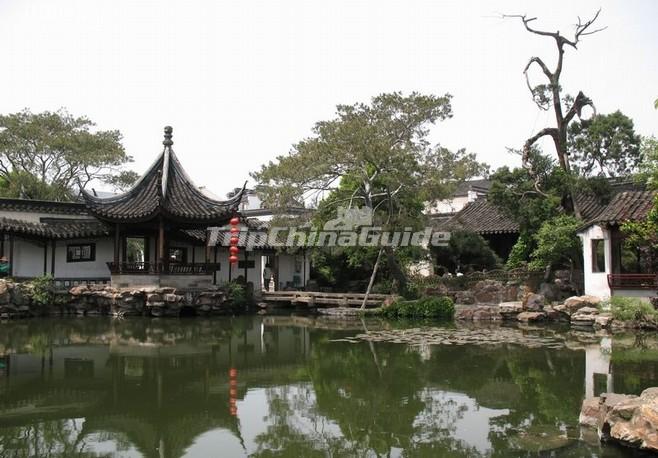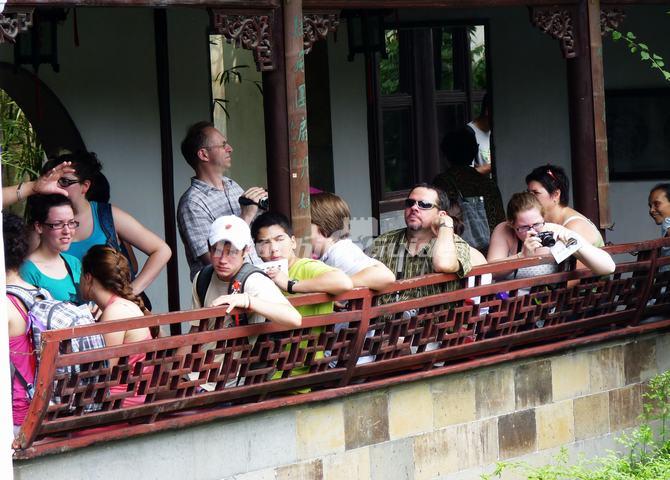Master of the Nets Garden
Originally known as the Fisherman's Retreat, the Master of the Nets Garden was built in Chunxi Year of Southern Song Dynasty (1174 A.D.) by Shi Lang (an ancient Chinese official title) Shi Zhengzhi after he retired from the Court. It is a private Garden with thousands of collected books. So it's also called the Hall of 10000 Volumes. Flower garden was built opposite the gate, which is called Yu Yin. During the Qian Long Period of Qing Dynasty (about 1765), a Shao Qing (a title) of Guanglu Temple named Song Zongyuan bought the Garden and make it a villa. The garden was enlarged with 12 scenes of storied building, pavilion, platform and etc., and Song Zongyuan named the Master-Of-Nets Scenery. In 1795 A.D., a merchant prince in Taicang named Qu Yuancun bought the garden and built Plum Blossom Tieshi Hill House, the Small Hill and Osmanthus Fragrant Pavilion, the Washing My Ribbon Pavilion, the Daohe House, the Moon Comes with Breeze Pavilion, the Cloudy Mountain, the Prunus Mume Pavilion, the Meditation Study etc. to make the basic layout of the current garden. The Garden followed the name of “Master-Of-Net”. The Garden was also named “Qu Garden ”as the owner had a family name of Qu. During the emperor Tong Zhi’s reign, the Garden was taken over by an An Cha Shi (Chinese Official Title) of Jiangsu named Li Hongyi and Li changed its name into “Su Lin Scenery”. After Li passed away, his heritor Li Shaomei inherited the Garden and added the Beauty within Reach Tower in the 22nd Year of Guang Xu Period (1896 A.D.). In the 33rd Year of the emperor Guang Xu’s reign (1907 A.D.), the Garden was transferred to General Da Gui of that Period. Later after Xin Hai Revolution, a warlord from Northeast China named Zhang Zuolin purchased the Garden from Da Gui at the expense of silver currency of 300,000 Liang (a Chinese currency unit). In the 5th Year of the Republic of China, Zhang Zuolin gave the Garden to his teacher Zhang Xiluan as a birthday present, and entitled it a new name “Yi Garden”. The Garden in this period was also called “Zhang’s Garden” and the spots of Full of Beauty Hall, Recalling Ancientry Pavilion, the Peony Study, Moon Sieving Pavilion etc. were all built then. Before the Anti-Japanese War, Zhang Daqian and his brother Zhang Shanzi, two great Chinese Painting masters, resided in the Garden, there’re also some modern inscription calligraphers and painters such as Ye Gongchuo living together. Dafeng Studio, the studio of the Zhang brothers, is just the Peony Study now. In 1940, a connoisseur and collector named He Yanong bought the Garden and resumed the name of "the Master of the Nets Garden". In 1950, the later generation of He Yanong donated the Garden to the country. In 1958, Suzhou Garden Management Bureau made overall refitting on the Master of the Nets Garden, the Cloud Stairway Hall was enlarged and new spots such as Green Jade Spring and Cold Spring Pavilion were built, the Garden was renewed then. In October of 1958, the the Master of the Nets Garden was formally opened to the public.

The Master of the Nets Garden only has an area of 5,400㎡, the garden can be divided into three major sections: housing area as the east section, where mansions concentrating; landscape scenery area as the middle section; and inner garden as the west section, which is also called Garden in Garden. The design of layout balanced the outer shape of the Garden and diversified the inner scenery as landscape changing. The east part is consisted with Ancestry Hall, Entrance Hall, the Sedan-chair Hall, Lobby (main hall) - the Hall of 10000 Volumes, fine bricks gate tower "Zao Yao Gao Xiang", inner hall (Women Hall, The Beauty within Reach Tower) and the Cloud Stairway Hall. The middle part is consisted with Tieshi Hill House, the Music Room, the Daohe House, the Washing My Ribbon Pavilion, the Rosy Clouds Pool, the Moon Comes with Breeze Pavilion, the Watching Pine and Appreciating Painting Studio, the Prunus Mume Pavilion, the Meditation Study, the Maid Tower, the Five Peak's Library, Duck Shooting Corridor and the Leading to Quietude Bridge (Three-step Bridge) The West Part is consisted with Dew Elite House, Green Jade Spring, Cold Spring Pavilion and the Peony Study. The architectures of the garden are outstanding by their beautiful shaping and delicate designs. The pavilions around the spring share the characters of small-sized, low height and penetrative patterns, the furniture in the pavilions are mainly made of rosewood, fancy and elegant. Yellow stones are used in the rockery, flower table and bank, and lake stones are used in other yards, the design is reasonable as avoiding the stones mixed together. There are not many plants in the Garden but each are essential, the main species of the plants are green maple, laurel, white bark pine, black pine, wisteria and yulan etc. Flowers such as peony are planted in the Dew Elite House. The cypress planted by Shi Zhengzhi, the first owner of the Garden, has witnessed the eras changing for nearly a thousands of years. With exquisite gardening techniques, deep cultural details and elegant garden intensions, the Master-Of-Net Garden won the title of the typical classical middle and small sized garden of River South without doubt, and as a "Perfect Small-sized Garden", the Garden has gain a high reputation at home and aboard.

Quite different from that at broad daylight, the classical Master of the Nets Garden's setting provides an atmosphere of peace and calm in the evening. It is relaxing and entertaining to tour the garden with the melodious notes of Chinese music. From the mid march to mid November, cultural performances, including local operas, folk songs, folk dance, and Chinese music, will be held every evening in exquisite pavilions and halls of Master-of-Nets Garden, the biggest stage, most realistic backdrop and ideal viewing place in which the landscape garden and performing are inextricably mixed. One is unable to tell whether he is in the garden enjoying the performing art or vice versa. Indeed, it is the most wonderful artistic conception.
Address: No.11 Koujiatou Lane, Suzhou City, Jiangsu, China
Entrance Fee
Busy season: ¥30.00 (April 16-October 30)
Off season: ¥20.00 (October 31 - April 15)
Opening Hours
7:30am - 17:30pm (March 1- November 15)
7:30am - 17:00pm (November 16-January 29)
Ask Question
Recommended China Tour Packages
In this section
- Suzhou Gate to the East
- Mountain Villa with Embracing...
- Lingering Garden
- Humble Administrator's Garden
- Guangqian Street
- Confucian Temple
- Surging Waves Pavilion
- Retreat and Reflection Garden
- Garden of Cultivation
- Twin Pagodas at Luohanyuan Templ...
- Suhzhou Embroidery
- Suzhou Kun Opera Museum
- North Temple Pagoda
- Couple's Retreat Garden
- Baodai Bridge
- See more
Find China Tours
Cities and Attractions interested in












